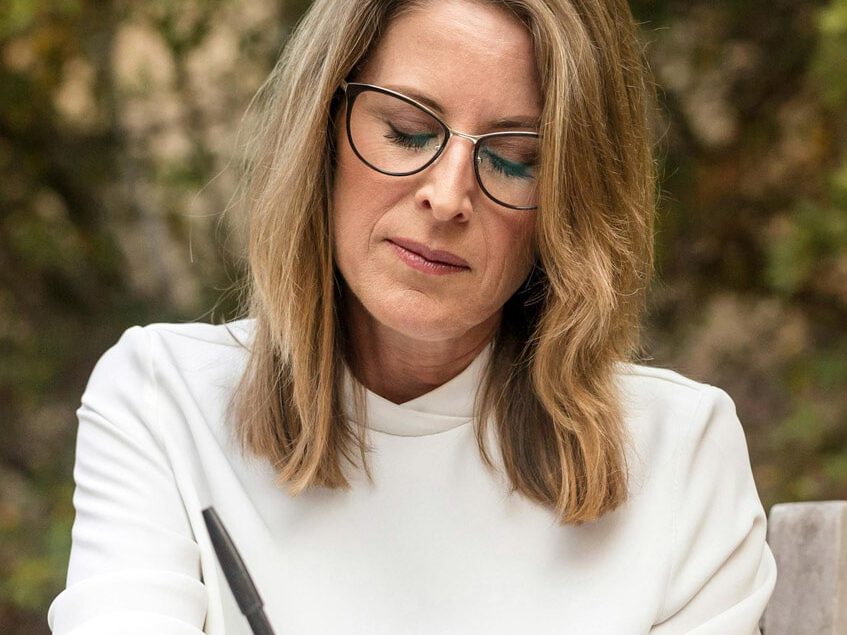Rubber Band Guns
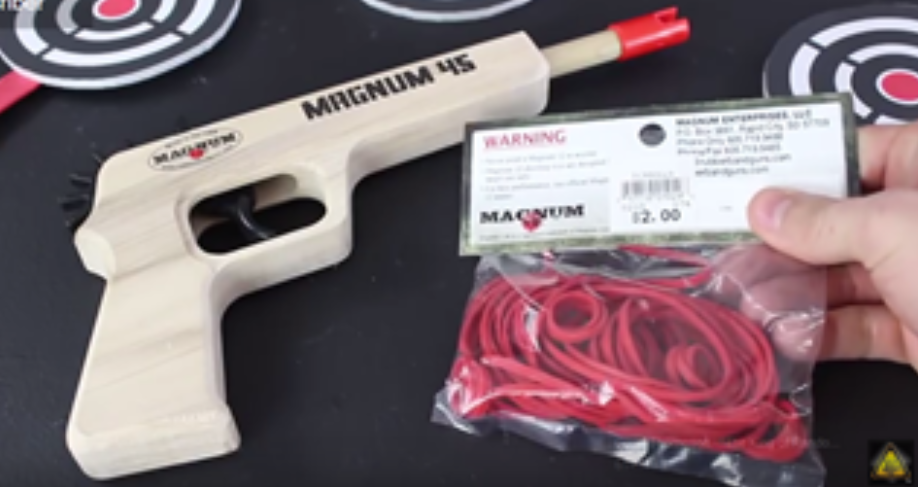
Store-bought rubber band gun
Above is an image of a store-bought rubber band gun that cost over $16.00 for the RBG plus $2.00 for the rubber bands that it shoots. But the price is not the real problem with this gun. The problem is that boys who simply buy toys in a store are not learning anything that will help them later in life. Making your own toys is one way for boys to learn how things work and how to create what they need for themselves. This creative activity is foundational in developing the masculine logic of boys so they will know how things work and how to make things for themselves.
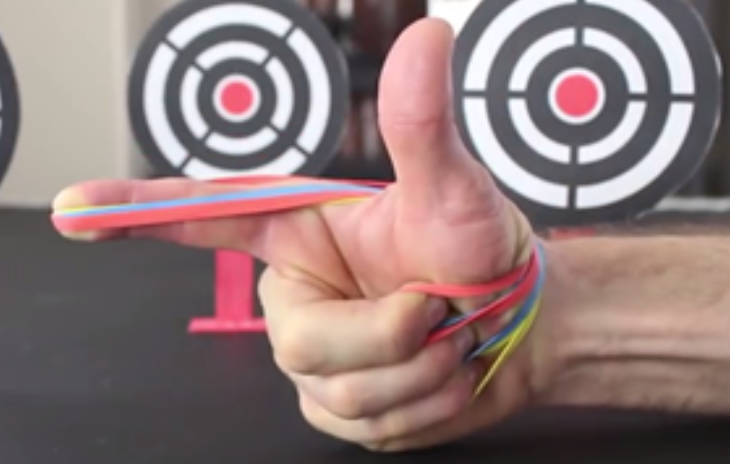
If the only goal is to shoot a rubber band, then a boy can save his money and just shoot some rubber bands using his fingers. The image above shows how a boy can release three shots with his fingers and use his index finger for aiming. In fact, this works just as good as the $16.00 store-bought gun and is just as accurate.
But our goal is not to just shoot some rubber bands but to have our boys learn something that they can apply to future projects which will cause him to become trainable. A boy who knows how things work will quickly be able to understand things better than boys who never made anything in their whole life! This can open doors for a young man later in his future when he develops a reputation as a problem-solver.
Farm boy who served a high ranking military officer
I personally met a guy who told me that he grew up on a farm and had learned many things during his childhood by hands-on experience. He said he discovered that often the simplest thing can cause something to malfunction and often people are looking for something complex when diagnosing problems and miss that which is simple. They had a neighbor for example that had a pickup truck that would die every time the motor heated up. No mechanic was able to find the problem because they were all looking for some big problem. This boy however found a small electrical connection that would fail every time the wiring was heated up and this caused the electrical system to break connection and short-out (just like turning off the ignition switch). He fixed this small detail and the neighbor never had a problem with this pickup malfunctioning again!
Later this same boy grew up and entered into the military. He happened to be at an Airforce base when a high-ranking Airforce officer was present. They were having problems with the aircraft of this officer and none of the engineers could solve the problem. This farm boy asked for permission if he could take a look at the aircraft and they told him that they had the best engineers available working on it and yet they could not find the problem. He asked them to let him look at it anyway and they finally consented. He examined the connections that ran to the jet engine and found one that was loose. When he corrected this small detail and then the jet engine functioned flawlessly! The officer was impressed at the ability of this farm boy to diagnose problems so he sent him to aircraft maintenance school and after graduation he become the personal mechanic for this officer and served on his aircraft crew. He told me that he “had it made” in the military after that because he had special privileges and was able to eat in the officer’s mess hall and even had special living quarters that were much better than those of the enlisted men. On one occasion he even met a president of the United States when the president flew aboard the aircraft that he was servicing. All of this promotion and privilege came because this farm boy learned how to fix things on the farm and understood that details should not be overlooked. The same principle he applied to fixing a pickup truck on the farm also worked when he fixed the aircraft of a high-ranking officer in the Airforce! The moral of the story is that this boy’s gift made a way of promotion for him. But if he had not prepared himself during his youth by learning practical things with hands-on experience on the farm then he may never have seen the great promotion and privilege he experienced while in the Airforce.
Farmers and ranchers do not typically hire their work done but most often do it themselves. This gives rural boys an edge over urban boys because they have a wide experience in working with things, before they enter the military or any profession. Farm boys typically do carpentry, welding, electrical wiring, auto mechanics, hunting, shooting, fishing, butchering and processing meat and even veterinary work. This wide breadth of experience enables rural boys to become trainable.
This proved true when rural boys were chosen to be helicopter pilots in Vietnam. They had a wide experience of how things work and operated trucks and tractors and numerous machines before they came to the military. When presented with a new task (like flying a chopper) they were easily able to catchup and understand the instruction given to them. This was not the case with most urban boys who just stood there in a bewildered manner much like a cow staring at a new gate! That is an expression of someone who is at a complete loss of what they are supposed to do when presented with learning a new task.
Making their own toys is one way to develop the understanding of a boy from his youth about how things work and operate. This causes him to have a foundation of experience by which he can comprehend and understand more complex tasks presented to him in later life. It is for this reason that making a toy (like a rubber band gun) is not a waste of time. It is this knowledge that a boy receives making such things that will prove invaluable to him later in life. However, a boy learns nothing by buying a store-bought toy that he did participate in creating.
Rubber Band Guns for Learning
A boy can start out with the simplest design like shooting a rubber band from his own pointed finger. Then he can progress to ever more elaborate designs that will challenge and expand his creativity with each increased level of complexity.
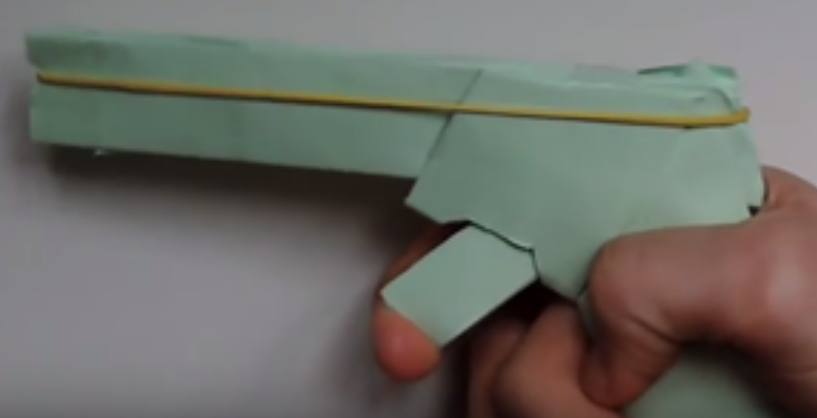
This rubber band gun (RBG) is made of paper but it is a bit more advanced than shooting a rubber band from a pointed finger. It has a piece of paper for a trigger that slides into the gun and releases the rubber band when it is pressed. This teaches the basic concept of how a trigger works and even a boy of young age can comprehend this basic principle.
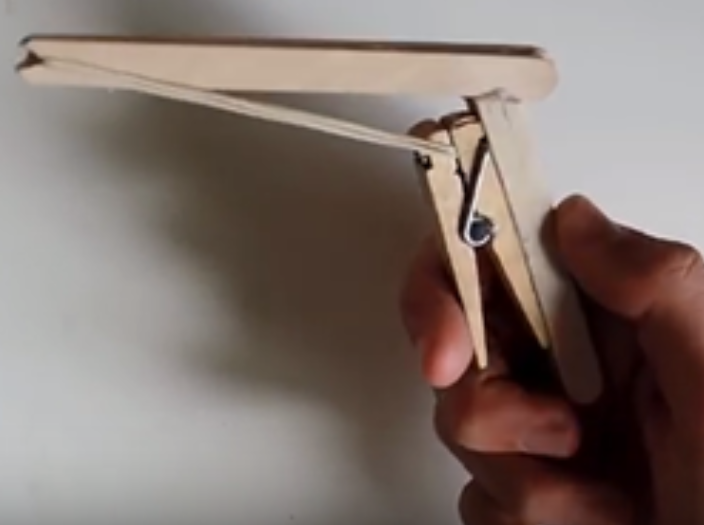
This is a bit more advanced over the paper RBG. It is operated by squeezing the clothes pin to release the rubber band. This is not really a good design because the rubber band is not released in a straight line so accuracy is poor. But this still provides a good learning process so a young boy can see how to make an improved model that is better than this one.

The models above are made with sticks and rubber bands but both are able to release the rubber bands using a trigger system. These models release their rubber bands in a straight line so are better than the type listed before them. These projects (regardless of how simple they are) serve to develop creativity in young boys whenever they make them. Such creativity is not gained by purchasing store-bought toys.
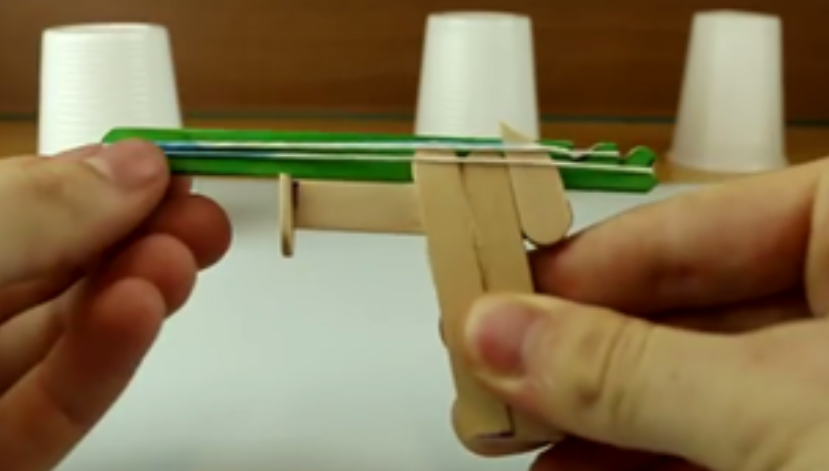
This type of RBG uses simple popsicle sticks in its construction but it has an advanced feature of being able to shoot three rubber bands with the bull of the trigger. A slide is moved backward when the trigger is pulled so it releases the rubber bands from their notches. It can release all three shots rapidly or one at a time. It shows a bit of progression in design compared to the previous models.
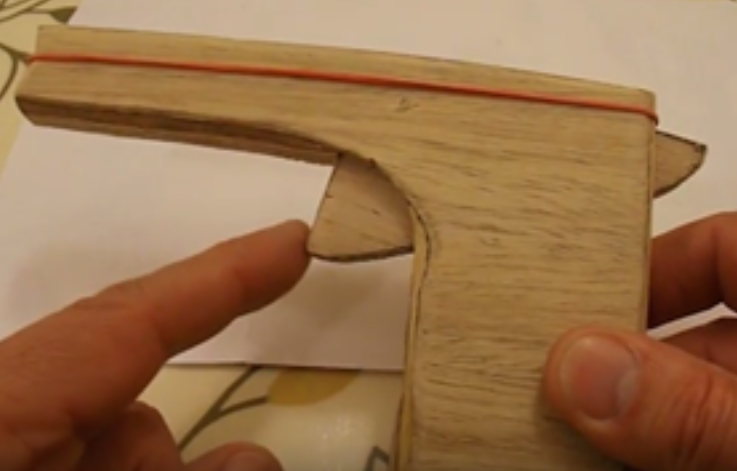
This model has progressed beyond using popsicle sticks and uses a simple wood template. It has a simple trigger (sandwiched between two wooden forms) that releases the rubber band when squeezed. Again, this is more progressive than previous models of paper or popsicle sticks (except this type is only a single shot).
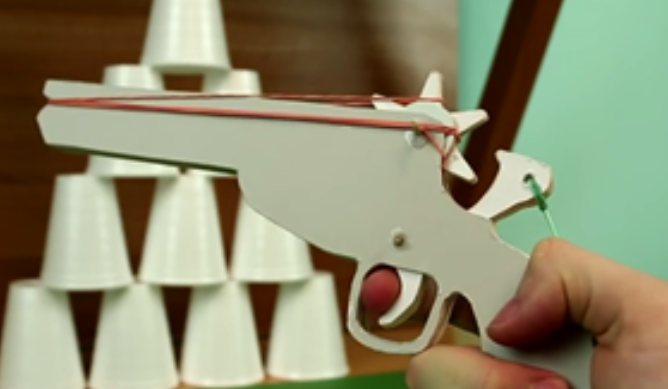
This model is made out of cardboard instead of wood but at the same time it has a better release system to fire multiple rubber bands. The trigger is connected to a hook that stops a rotating star-wheel from turning. This enables multiple single-shots by having the star rotate one notch at a time to release a single rubber band.

These types of models have an internal slide mechanism that releases the rubber bands from notches in the rear of the gun when the trigger is pressed. These are more advanced in design than previous models mentioned.

Herein the designs begin to progress beyond just shooting a rubber band. This model is actually shaped to look like a Glock. The boy who designed this model even created drawings so that he could cut out and glue the paper pattern to wood and then cut the parts out of wood to the right size. Drawing working plans reveals that this young man has thought out what he is going to make in advance. This is better than just building something as he goes along and seeing how it turns out. His plans can be easily reproduced by anyone else (unlike those designs that have no plans created to benefit others).
His simple star-wheel design holds four shots and the trigger releases the star to rotate a quarter-turn each time the trigger is pulled. This allows semi-automatic fire with each pull of the trigger. In terms of having a simple and easy to make design that is patterned after a real gun shape, this is probably the best design so far because it is simple to make and it has some authenticity in appearance. It is amazing that something with so few parts can be so functional in design and authentic in appearance as this RBG design is!
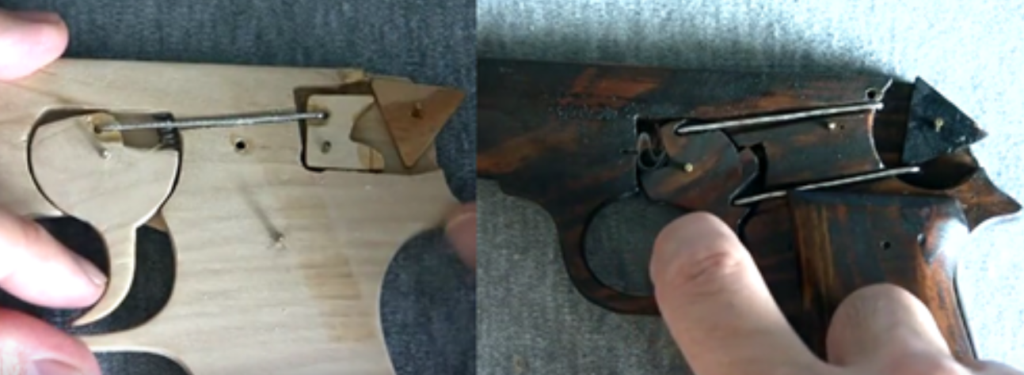
Two different designs pictured above both use a triangle-shaped wheel to hold three shots. Each pull of the trigger will release one rubber band. The design on the left uses a wooden catch system attached to the trigger to control the rotation of the triangle-shaped wheel. The design on the right works on the same principle but uses two independent rods to release and to hold the triangle-shaped wheel between each shot. The design on the left utilizes a small coil spring to reset the trigger between shots and the design on the right uses a piece of sheet metal for a spring to reset the trigger.
The differences in these two designs illustrates the fact that there are a number of ways to solve a problem. Both systems work for controlling a triangle-shaped rubber band release wheel. Boys who make both designs will see how they are similar but different and how both designs accomplish the same purpose. Depending on what materials they have available and what works the best, the boys can choose the system that is best suited to their needs. This is yet another way to develop the reasoning and masculine logic of boys.

The RBG above is an advanced design created by Tenkou Kaku of Japan. It is patterned to look like the Colt Automatic Pistol invented by John Browning in 1911. This is fully functional in that it can shoot rubber bands and at the same time it also has a slide that blows-back under rubber band power. The blow-back slide looks just like a real 1911 in operation. This design combines shooting rubber bands with an authentic look and cyclic action. Tenkou Kaku has plans that can be downloaded and printed off on paper. The patterns are cut out of paper and glued onto wood and then the parts are cut out of wood. The image on the right shows the parts after being cut out of wood with the paper patterns still intact.

The image on the left shows the trigger in the forward position and the middle image shows the trigger half-depressed and the third stage (on the right) shows the trigger fully depressed which causes the slide to snap fully to the rear at the end of the trigger stroke. The slide cycles and it also fires a rubber band from the star-wheel located in the rear of the slide.
Building these plans will take a boy to a whole new level of expertise. It takes much longer to make this model but the boy will learn vastly more in making this design than all previous models mentioned. He will see how the interrelationship of parts work together to cause this RBG model to function.
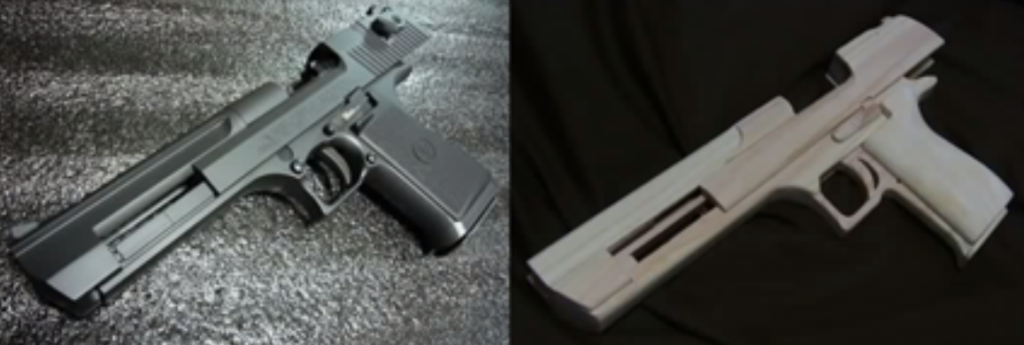
When a boy progresses to an advanced level then he can make a design that looks like the real thing and can function like the real thing but only shoots rubber bands. The gun on the right is a real Israeli made Desert Eagle automatic pistol and the one on the right is a RBG model that matches the real gun in similar dimensions.

Above is a RBG designed to look much like the original gun. The image on the left shows the parts that make up a Desert Eagle RBG model. There is also a magazine which can hold wooden casings. This design will shoot rubber bands, cycle the action, and even eject wooden imitation spent casings! This combines authentic looks and cyclic action together with casing ejection. All of this is powered by rubber bands. When a boy is able to reach this level of expertise, he will have become proficient in understanding the interrelationship of parts and parts design and how things work. It is this experience that will help him in real life when he designs new innovations of his own.

This model has a magazine that holds simulated wooden shell casings. The magazine is loaded like a real Desert Eagle by inserting it into the handgrip of the gun. When the trigger is pulled then the RBG fires a rubber band and the slide cycles back and ejects a simulated wooden shell casing. Then the slide snaps forward again and is ready to fire the next rubber band and eject the next shell casing in the magazine within the grip.

In this advanced model, not only does it fire a rubber band, cycle the action and eject a simulated spent casing but it also locks open after the last round is fired. The image on the right shows the Desert Eagle RBG after it has locked open after the last round is fired. This is just like the real Desert Eagle that locks open after the last round is fired allowing for a magazine change and reload.
This is truly an advanced RBG design that will add to the knowledge gained by boys who made previous mentioned simple models. Each model design becomes more progressively advanced. By the time a boy has reached this advanced level there will be few things that he cannot design himself. Every skill-level that a boy attains provides him with further knowledge and experience to enable him to comprehend more advanced models. This is how we develop the analytical and problem-solving skills of boys by starting with simple models and progressing to more advance models.
A baby cannot run before they learn to walk and the same is true of developing the masculine logic of boys. They cannot start with advanced projects until they first master the elementary principles involved in making simple models. We always strive to take the boys higher so that they will gain the skills necessary to make advanced innovations and multisystem creations later in life.

At advanced levels students will be able to imitate the shape and contour and design lines of real guns and incorporate them into the design of their RBG models. This takes them to a level of expertise that goes beyond just shooting rubber bands and seeks to incorporate authenticity in their working models. The model above has removable magazine, simulated shell casings, and will fire rubber bands, cycle, and eject wooden casings. All of this is done from a compact model.
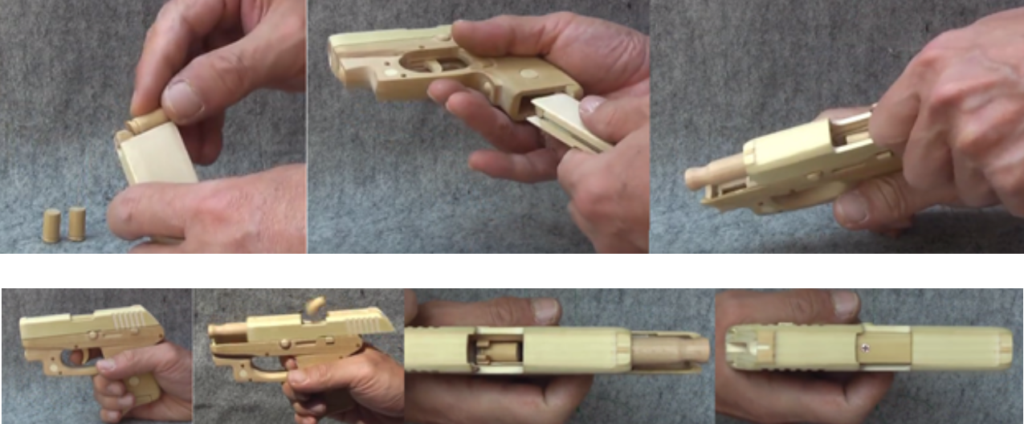
This working model Ruger LCP RBG operates much like a real gun. It is more advanced and more difficult to make because of the compact size. Smaller parts are harder to work with than large parts (as are found on something like a Desert Eagle model). As with all projects they should get increasingly difficult in order to test the skills of the young men and develop their masculine logic.

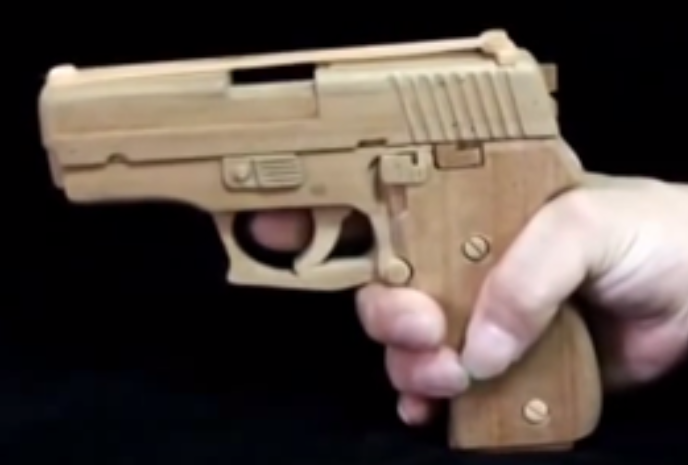
his model also shoots rubber bands, and cycles the action with every shot. It is patterned to look almost identical with a real functioning SIG SAUER. Being able to add authenticity together with function is a goal for those making advanced models like this.

The RBG on the right is patterned to look similar to a WWII German StG45 machine gun. It fires rubber bands from a star-wheel located above the trigger. It can fire semi-auto with each pull of the trigger but it also has a full-auto switch allowing the rapid fire of all the rubber bands when the trigger is depressed. So, this RBG operates much like a real machinegun that can fire either semi-automatic or fully-automatic.

On top is pictured a full-scale model of a Smith and Wesson .44 Magnum revolver. The detail in this gun is astounding and it is a real work of art and is evidence that this model builder has advanced skills. Skills like these are what we endeavor to impart to our young men through the creation of these working models.

This model above is patterned after a Scofield revolver. It has a rotating star within the cylinder that holds the rubber bands in place. With each pull of the trigger the star rotates and releases a rubber band. This is an advanced and highly creative way to use a rotating star with a RBG revolver to shoot rubber bands in single-action mode.
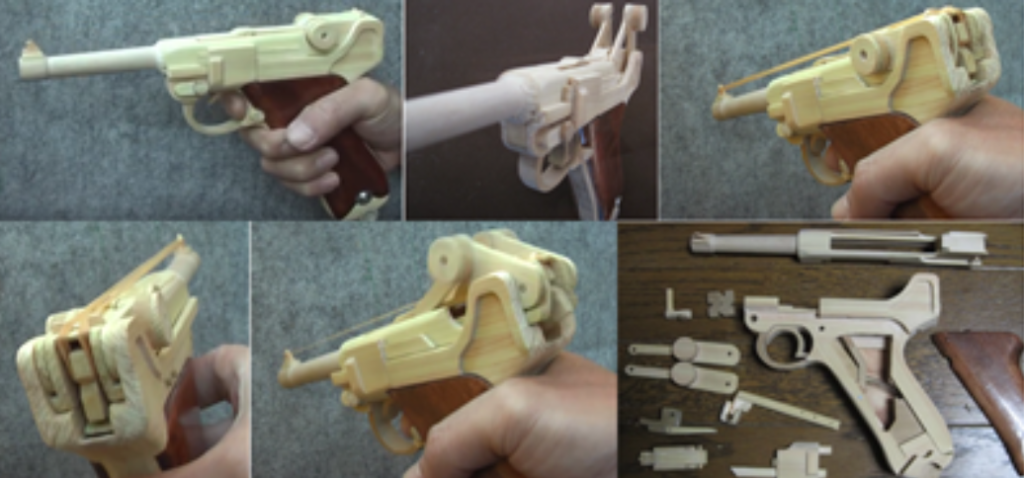
This is a more advanced RBG model patterned after a German Luger Pistol. It fires rubber bands from a star-wheel in the back of the action. It also cycles in the same manner that a real toggled- locked Luger pistol would do with the top elbow hinge of the action protruding up when cycling. This design was created in 1898 by Georg J. Luger and is simulated in this advanced design Luger type RBG.

This is an advanced working model patterned after a Glock type gun. It will shoot rubber bands, blow-back the action and eject a simulated wooden shell casing. This advanced model will display the skills and ingenuity of our student innovators.

This UZI type RBG is unique in that it has loadable magazines that can be preloaded with stretched rubber bands. When a magazine is empty it can be quickly replaced so the model can continue firing. It can shoot semi or full auto and has a detachable stock as well. The designer of this gun was clever in adapting it so it could take magazines that are loaded on top of the gun. This is an example of adapting principles learned from other projects then adding a new idea of your own to make a truly unique creation.

This is an ingenious design that incorporates a bolt action that pulls a carriage back when the bolt is cycled. This carriage is released upon pulling the trigger. This causes the star-wheel to turn a quarter-turn and release a shot. It also has a detachable box magazine for rubber band storage and a removable simulated scope, detachable rear sights and a working bipod. The idea with these models is to be as authentic in design as possible and still create a working model RBG.


Another 1911 design RBG on the right with good appearance and contours and a Walther P-38 German pistol RBG patterned after the one designed in 1938 as a replacement to the more expensive to produce Luger.
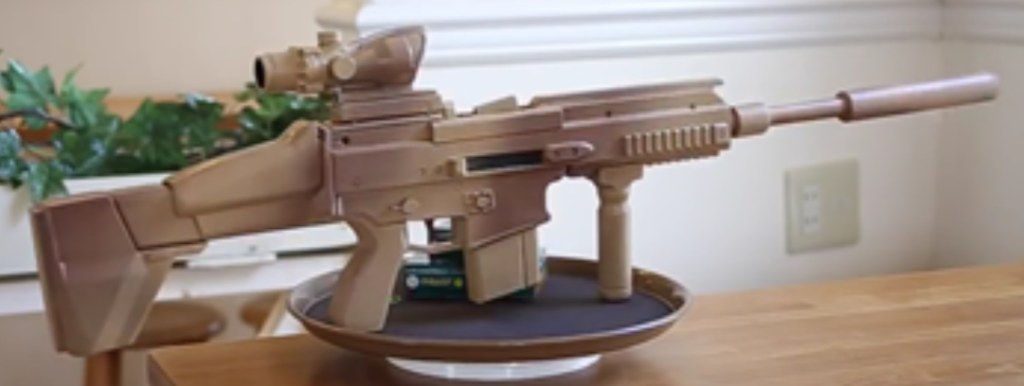

RBG designs can be as varied as the young men who make them. Advanced models will seek to produce both authentic appearance together with multifunction. Having a model that can shoot rubber bands, cycle, and eject simulated spent casings shows the highest level of expertise in model making.
